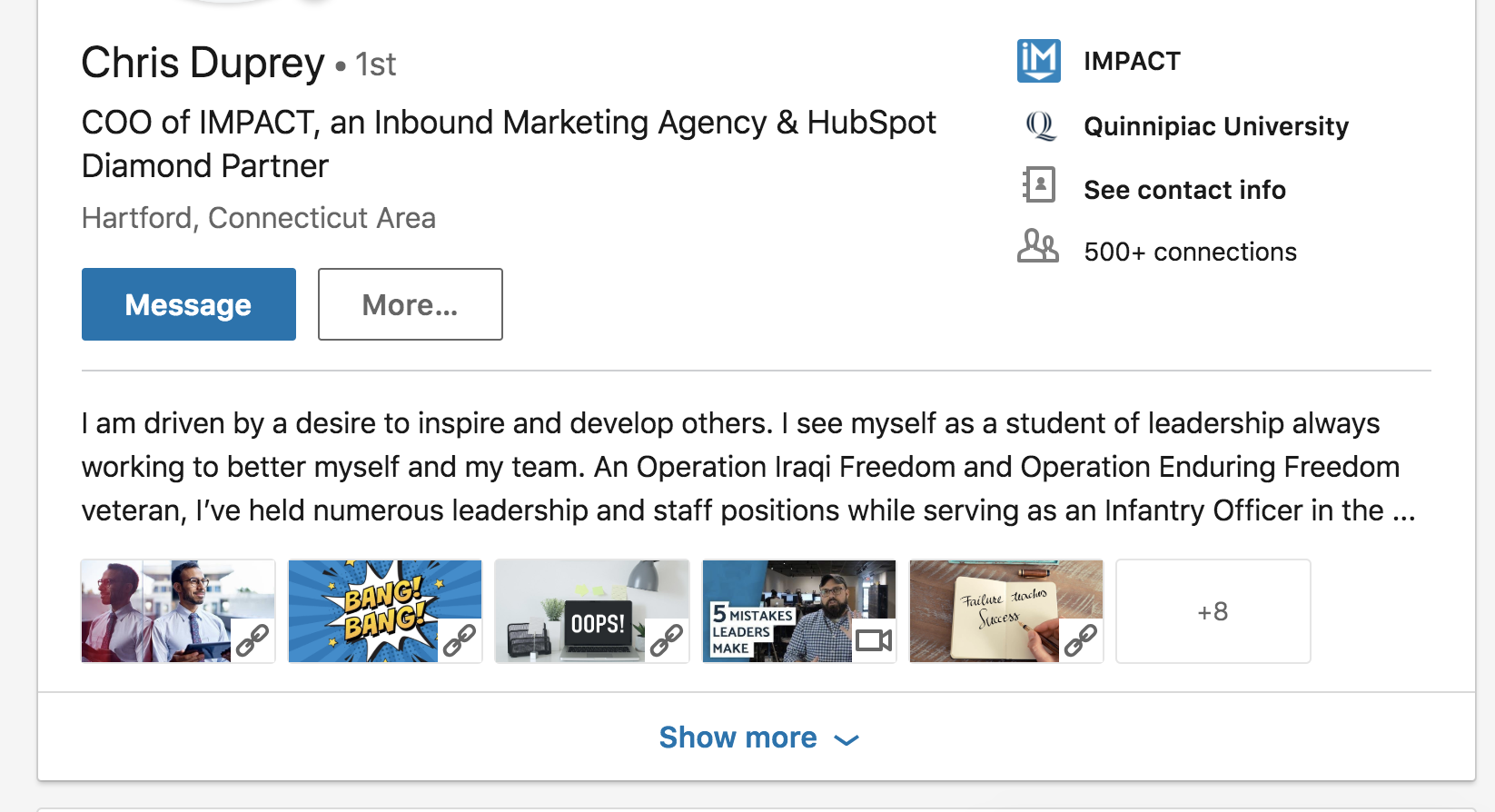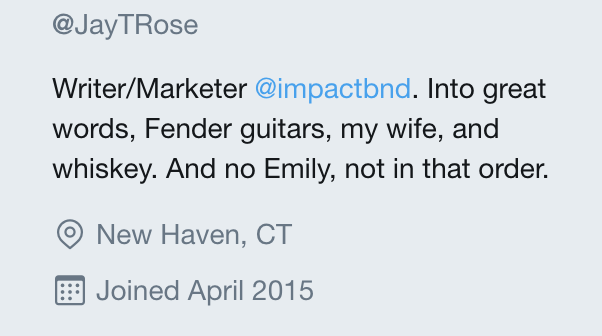Subscribe now and get the latest podcast releases delivered straight to your inbox.
How to Write a Bio
To write a bio pick the right point of view, establish why you're qualified, and show, don't just tell. Don't make it all about you. The point of the bio is for the person reading it to know what's in it for them. Now it's time to tailor your bio to where it will live. Bios aren't one size fits all...
Maybe you just got a snazzy new job or a big promotion.
Or maybe you’re about boost your brand with a speaking gig or a blog contribution and your professional bio has gone the way of those tortilla chips in the back of the cabinet (a bit stale).
Either way, it’s time to chain yourself to your keyboard and write something we all dread -- a professional bio.
Writing about yourself isn’t easy. It’s a fine line between cocky and confident and you’re never quite sure when you’ve locked down the totality of your career and passions.
Full transparency: When I started at IMPACT in February, I had to write one of these monsters myself -- and to be honest, I don’t like how it came out:
“Jason is a journalist-turned-marketer passionate about how storytelling and targeted messaging create business-changing content.
As an Account Executive, he is responsible for implementing inbound marketing strategies that help his clients increase brand awareness, generate leads, and acquire new customers.
When he isn’t working, you’ll find Jason reading on the beach, hunting down mono vinyl, and playing guitar.”
I’m going to hit two birds with this post and provide actionable tips and advice that will help put your mind (and mine) at ease so we can write better professional bios.
After all, this is some of the most important public-facing copy we will ever write. When done right, your bio can help expand your personal brand, build awareness for yourself and your business, or even win you new business.
Upon these words rest the fate of our entire careers.
Okay, I’m being hyperbolic but you get it; Our bios are an important first impression and we often neglect them because it is uncomfortable to write about ourselves.
Without further adieu, this is my guide to writing badass bios for every major platform.
General Tips
Let’s start with some quick things you should, and shouldn’t, do no matter where the bio is going to be posted.
Things you should do:
- Pick the Right Point of View
When deciding whether to write your bio in the first (I) or third (Jason Rose) person, the general rule of thumb is to consider who is introducing you.
Meaning, when your bio appears on a company page, you are being introduced by your company so it makes sense to use the third person.
Ditto for conferences or most publications. I know it makes you feel like Kanye West, but unless it’s explicitly requested, get those “I”s out of your bio.
On the other hand, when you are writing a bio for your social media profile, it is better to the use the first person. Here you’re perceived as the “publisher,” so you’re introducing yourself.
- Establish why you’re qualified (but be human)
It’s a tall order, but a good bio establishes your experience and qualifications, but also that you’re a human being complete with a pulse and a personality.
If an AI application could machine-learn how to write your bio by crawling job descriptions — you’re doing something wrong.
Have a human voice and tone that is professional enough to represent you from 9 to 5, but doesn’t completely betray who you are from 7 to 10.
Even if you’re in a field that is very conservative, use human language and avoid jargon specific to your industry.
Things you shouldn’t do:
- Play Buzzword Bingo
It’s easier to learn from the don'ts than the do’s — so I will fall back on my sword.
I think my least favorite thing about my bio is the sour note I played with this first sentence.
“Jason is a journalist-turned-marketer passionate about how storytelling and targeted messaging create business-changing content.”
Journalist-turned-marketer is interesting enough and conveys my career path but everything after passionate is a buzzword or a conjunction setting up another buzzword.
That’s not to say buzzwords don’t have their place. After all, they communicate to an audience that you’re in their tribe and have a shared language, but, when we take industry jargon too far, we are just hiding behind it and safely filling space.
It’s better to speak in universal terms that resonate with your community, but could be understood by anyone.
When possible, break away from buzzwords and you’ll stand out from the sea of sameness.
- Be all tell, no show
Someone as apparently “passionate about storytelling” as I am should know to follow the most golden of all story rules.
Show, don’t tell.
According to wikipedia, this idiom is credited to Russian playwright Anton Chekhov who said "Don't tell me the moon is shining; show me the glint of light on broken glass."
You may be working with fewer characters than Chekhov, but whenever possible don’t tell someone who you are, show them.
Fellow IMPACTer Liz Murphy’s bio is a great example of this.
“As IMPACT's content strategist, Liz does more than wrangle commas. With more than 10 years of editorial and inbound marketing experience, she's obsessed with innovating new ways of creating amazing content that's absurdly useful and effective. (She also works with in-house contributors and clients as an editor, strategist, interviewer, coach, and sometimes therapist.)”
What a great first note.
I started my bio with a screeching violin and this is Jimmy Page’s first bend in the Stairway to Heaven guitar solo (the moment that song no longer sucks).
Instead of telling you “I’m skilled editorially but can wear many marketing hats” with her first sentence, Liz showed you: “As IMPACT's content strategist, Liz does more than wrangle commas.
Bravo, Liz.
- Make it all about you
How dare you make your bio all about yourself.
Like any great copy, if your bio doesn’t explicitly its intended audience value, it’s dead on arrival.
Using Liz’s bio once again as an example, “No matter which hat she's wearing, her goal is simple -- to empower organizations and thought leaders to differentiate themselves and drive measurable results through game-changing content.
Throughout her career, Liz has worked with organizations across a wide range of industries -- from cyber security and health care, to government sales and insurance.”
If I’m a business stakeholder reading this bio, I know what’s in it for me.
Different Copy for Different Platforms
While the tips above are best practices no matter what, bios aren’t one size fits all and each platform has specific constraints and considerations.
Let’s discuss some of the most common and important:
1. The Company/Team Page
The most important thing to keep in mind when writing a professional bio for your company’s collateral is that you want to differentiate yourself, but within the value proposition of your company and in their voice and tone.
To put it simply, you want to stand out but not too much.
I think we all agree that consistent messaging is a must for any brand or business, but I still sometimes come across impeccably written websites with a singular voice and tone, until I get to the author bios.
Then, suddenly the organization feels like a collection of individuals, and no matter how interesting they all personally appear to be, they don’t communicate that this business is a united entity focused on providing me the product, solution, or service I sorely need.
2. Blogs and third-party publications
The best advice I have to offer with blog bios is to ensure that it speaks directly to the subject you are writing about.
Think Aristotle’s ethical appeals. There is no ethos in using the limited inline space of a blog about quantum physics to share that you love to snowboard.
For third-party publications, you’ll usually have to defer to the style prescribed by the editor.
My suggestion: use the bio to sneak in a link back to one of your owned web properties.
Aside from that sweet link juice, this sends users who like your article to somewhere you have complete control of messaging and how they can engage with you.
3. LinkedIn
LinkedIn caps your bio (called a summary here) at 2,000 characters.
This gives you plenty of real estate to stretch out and write more, but just because you can, doesn’t mean you should.
Keep it tight and only share as much is necessary to tell your story.
Also, be cognizant of what is visible before the visitor expands the module and clicks <see more>.
If you’re buying the good stuff, chances are no one is going to click show more.
Chris, our COO at IMPACT, does a great job in his LinkedIn summary of differentiating himself with his core principles and military background before the user has to click.

4. Facebook
Unlike LinkedIn, Facebook only gives you 101 characters to share your story.
It does, however, give you the unique option to set your bio as permanent or temporary in 1 hour, 1 day, 1 week, or custom increments. These temporary bios keep the information fresh and allow you to describe not just who you are, but what is most exciting in your career right now.

For many of us, Facebook is largely a platform for our personal relationships, while professional networking activities live on LinkedIn, but if you’re building a personal brand, your Facebook page is an integral asset.
For tips and tricks about how to build a personal brand with Facebook, I defer to the always informative Neil Patel.
5. Twitter
While I’ve made my feelings about my company bio clear, I actually like my Twitter Bio.

The constraints (160 characters) and the short-hand of the platform provide the opportunity to get creative. It’s also worth noting that the platform is comparatively much less stuffy than LinkedIn, so feel free to have fun with it.
Just don’t go full 2014 with MARKETER | WRITER | LOVER OF PANDAS or mention that you like to drink coffee.
While I haven’t taken advantage, it’s a good idea to hashtag any industry relevant keywords to boost the discoverability of your profile, and don’t forget to @ your company!
6. Instagram
Instagram bios force you to make due with 150 characters or less.
Given the platform’s users can’t put links into posts, that is one of the most important functions of the bio.
Like Twitter, make sure you include hashtags that lead to relevant galleries, or @ links that lead to your company’s profile.
Think of your Instagram bio almost like PPC ad copy that you are using to drive people to content. You have to be short and savvy about how you use your space.
7. Speaking Proposals and Collateral
The great thing about writing your bio for speaking engagements is that you know the specific audience it should be tailored for.
So often we struggle with our LinkedIn/Twitter/Company bios because we are trying to be all things to all people.
To knock your speaking bio out of the park, learn all you can about the audience for the specific event or conference. Who has attended in the past? What was the most popular topic?
Uncover their needs (articulated or not), and tailor your bio messaging to demonstrate why you will be the speaker that’s forcing latecomers to stand in the back.
I hoped this post helped you shed imposter syndrome (I’m projecting) and now you can write bios for any platform that put your best foot forward.


Order Your Copy of Marcus Sheridan's New Book — Endless Customers!

